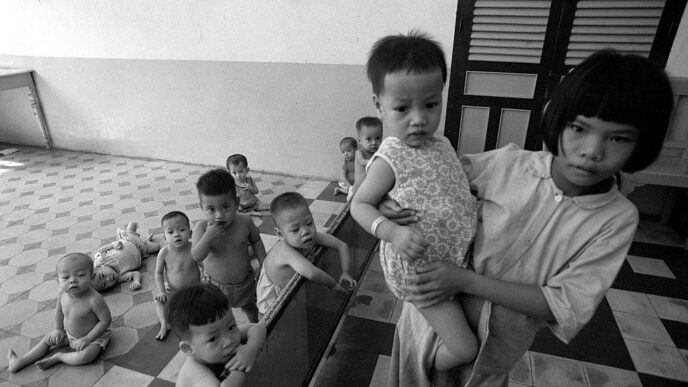“With any story, you’re primed to believe what you’re being told,” says Katie Robbins. The creator, co-showrunner, executive producer, and writer of Hulu’s Good American Family knows exactly how a story can become a slippery thing. The show dramatizes the real story the Barnett family adopting Natalia Grace, a child with dwarfism, in 2010. Their life as a family turned into a nightmare when the Barnetts became convinced that Natalia was an adult trying to con them, until they severed ties with her.
It’s a story that’s infinitely more bizarre than fiction. When researching the real people involved in the story, Robbins was struck by how each article she’d read seemed to tell an entirely different side of the story. Her own opinions continued to flip back and forth, and it felt remarkably difficult to get to the truth of the story.
This influenced Robbins to tell Good American Family through multiple perspectives. First, through the eyes of Kristine and Michael Barnett (Ellen Pompeo and Mark Duplass) in the first few episodes, before shifting to Natalia Grace (Imogen Faith Reid) in the second half of the show. The finale, which airs Wednesday on Hulu, brings together everyone’s perspectives as things come to a head when Kristine and Michael Barnett are charged with neglect, leading to an intense battle in court.
Here, Robbins breaks down the major revelations of the Good American Family ending, including a major loophole that changed the trajectory of Natalia’s case.
Making a show that makes you question everything
The idea for making Good American Family came back in 2020, two years before the real trial took place. But due COVID delays, the writing began after the case had concluded. “By the time we were writing, we had depositions, court documents, Facebook messages, doctors’ records—we had a treasure trove of information, which is incredible, but very daunting,” Robbins says. She compared it to being a sculptor working with a giant stone: “You have to chisel away at it to find the story within that you’re trying to tell.”
One of the most remarkable elements of Good American Family has been the move from the Barnetts to Natalia’s perspective, which was “a way of allowing the audience to grapple with their biases, and question why we believe the stories that we believe,” Robbins says. Viewers expressed remorse online after they realized that Natalia was just an innocent child, and not someone out to ruin bring the Barnetts down.
“I’ve seen people saying, ‘Why did I think that? Like, why did I believe them? Why did I trust what I was seeing? Why didn’t I ask more questions?’ And that’s something we all need to be doing in our lives all the time, which is moving through the world with curiosity and empathy. And amazingly, that seems to be happening with this show,” Robbins says.

What happens in the finale?
At the beginning of the Good American Family finale, Kristine and Michael are assembling evidence with their lawyers for the upcoming case in which they are being charged with neglect of a dependent and conspiracy to commit neglect of a dependent. All they’re missing is character witnesses. Their confidence begins to crumble when they realize the people they thought they could count on—the school principal, Natalia’s first adoptive mother, the doctors—see things very differently than they do. The scene is deliberately edited to feel like a cross-examination in court.
Kristine even loses the faith of her greatest ally, her friend and neighbor Val (Sarayu Blue). Kristine was instrumental in helping Val’s daughter, and Val has been supporting Kristine emotionally and financially ever since. But when Kristine asks Val if she’d be willing to testify about Natalia’s character, Val has a realization that she’s never actually seen any of the horrible things Kristine has alleged. “When a friend tells you something, you believe it because of who they are—you don’t ask questions,” Robbins says.
On the other side of the suit, Natalia’s lawyers have made a major discovery: shocking Facebook messages sent between Kristine and Michael about Natalia. The pair hurl insults about her including calling her a “thing” and a “smoked out hungover hooker.” It’s the scale of messages that proves even more heartwrenching. A slow zoom out reveals a large table full of seemingly endless stacks of paper full of messages. “Those are all real. Our research team got all of the Facebook messages, and the stacks that you see are literally representative of how many messages there were,” Robbins says. “It’s not hyperbolic. The messages read in the show are the tip of the iceberg.”
Natalia is understandably crushed reading through the messages, but she doesn’t break down. There’s a sense that the years of abuse have hardened her. Robbins points out a “world weariness” in Natalia despite her young age. She’s been burdened by the world’s bias towards people with disabilities for her entire life. Still, vulnerability seeps through: “It’s the way a lot of people talk about people like me,” Natalia tells Detective Drysdale.
But the show’s biggest revelation is saved for the final episode. Before the case gets underway in court, the Barnetts’ attorney uses a legal loophole that effectively bans any discussion of Natalia’s real age in the trial. What looked like an open-and-shut victory for Natalia has suddenly become an impossible case. How can they prove that Natalia was abused as a child if they can’t use any evidence that shows she was a child?

“At the end of the day, it didn’t end up mattering in the court of law because the story had been told so well up to that point by the Barnetts. That just blew my mind,” Robbins says. “That was the scariest thing for me.”
This leads to a scene of great frustration, as various witnesses are repeatedly stopped from speaking because they reference Natalia’s age. One doctor snaps, “Are we just not interested in the truth here?”
According to Robbins, many of these moments are pulled straight from transcripts and depositions. “Doctors were saying, ‘How do you want me to do my job? Are we not interested in the truth?’”
“Having evidence-based facts is supposed to matter. That’s supposed to mean something. Yet it doesn’t in a court system that is meant to keep people safe and protect people’s rights. It’s the most horrifying thing in the show,” Robbins says.
In the show, Natalia is left with no choice but to lie under oath about her age and say she was born in 1989 and not her real birthdate of 2003. As the attorney demands she reveal her birth year, the show cuts between her crestfallen face and a montage of her experience with the Barnetts, from the joyous adoption to their scarring abandonment. In this moment, Natalia knows she’s lost the case. But more than that, she’s robbed of her identity and any belief that she may get justice for the torment she’s experienced at the hands of the Barnetts.
How Good American Family ends
Later, Natalia visits Michael, hoping to understand why he let the abuse happen. Michael explains that “hurt people hurt people,” and tries to justify his actions, but he never apologizes. The only person Natalia gets an apology from is Michael and Kristine’s eldest son, Jacob (Aaron Potter): “She made us scared of you. But you were just a kid. I shouldn’t have listened. I’m very sorry.” Jacob was just a kid, too.
“Michael is a person who is deeply in denial for huge swaths of the show, and has these brief moments where he can see what it means about himself if he allows himself out of denial, and that’s terrifying. So he can’t stay in that state for longer than these little flickers,” Robbins says. Though this is heartbreaking for Natalia, Jacob’s apology is a beacon in the darkness.
Good American Family deals with generational trauma. We get glimpses of Kristine and Michael’s history, which suggests they’ve both had challenging upbringings. “Maybe in this little moment of grace between Jacob and Natalia, “there’s a semblance of hope that that pattern can be broken,” says Robbins.

The final episode of Good American Family is a challenging watch, but it ends with hope. Natalia returns home, dejected, but her new adopted siblings show her the supportive comments people are leaving online. Natalia is surprised and overwhelmed; a smile stretches over her face, and she exhales in relief. She may not have won the case, but she’s won the court of public opinion.
Robbins sees the ending as a full-circle moment for Natalia. “We start the story with like the way that Kristine and Michael are seeing Natalia, that depiction of her as a monster, and how that managed to have this incredibly long arc that would ultimately affect her in court,” Robbins says.
After the case, Natalia fears that she’ll be perceived as a monster and a con artist forever. “For the rest of my life, people will see me like the Barnetts want me to be, a monster. A 33-year-old monster,” Natalia tells her adopted mother, Cynthia Mans (Christina Hendricks), after she loses the case.
“And that isn’t the truth,” Robbins says. Throughout Good American Family, Natalia has longed to be valued, to be loved. She has experienced more abuse than most people could even imagine. But in the end, she’s standing in her power, finally embracing the love she’s longed for. She may not receive legal justice, but she knows that people see her fully, though the Barnett family tried to convince the world she was a monster.
All you can do is hope that’s enough.














